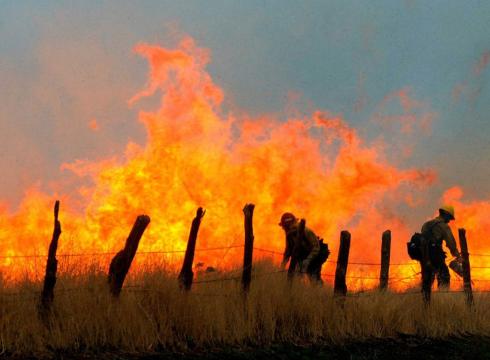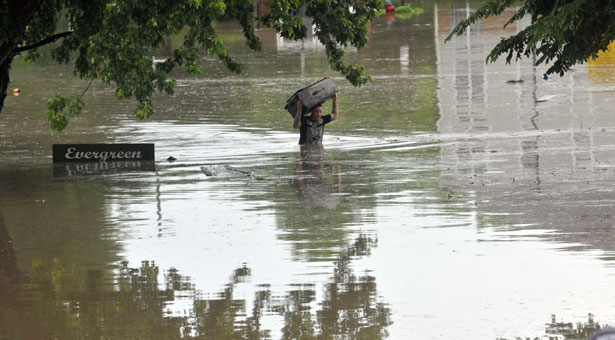
Never mind the debate over global warming, its possible causes and effects. We've got "global weirding."
That's how climatologist Bill Patzert describes the wide range of deadly weather effects that have whipped the nation this year, killing hundreds of people and doing billions of dollars in damage to homes, businesses, schools and churches.
"Sometimes it gets wild and weird," says Patzert, a research scientist at NASA's Jet Propulsion Laboratory in Pasadena, Calif.
In more technical terms, weather forecasters searching for a unifying explanation point to the La Niña climate pattern, a phenomenon born far out in the Pacific Ocean that shapes weather across the globe, in combination with other atmospheric anomalies that have altered the jet stream flow of air across North America.
Less famous than its warm-water climate sibling El Niño, this year's La Niña has been "near record-breaking" in its intensity, says climate scientist Michelle L'Heureux of the Climate Prediction Center in Camp Springs, Md.
La Niña is defined as cooler-than-normal sea-surface temperatures in the central and eastern tropical Pacific Ocean, which affect weather patterns around the world, according to the prediction center. La Niña conditions occur every few years and can persist for as long as two years.
"A lot of what is going on is consistent with a La Niña," says Steve Bowen, a meteorologist who tracks weather disasters at AON Corp., a global insurance broker.
"As of today, the U.S. has seen eight separate billion-dollar (weather) events," Bowen says. "This is one shy of the record nine separate billion-dollar events set in 2008."
So far, Bowen says the Mississippi Valley flooding is about a $5 billion disaster, while the Joplin, Mo., tornado may end up being "one of the costliest single tornadoes ever recorded."
Based on measurements of air pressure differences, another way of measuring La Niña besides sea-surface temperatures, this La Niña in February was the most intense on record. Accurate measurements go back to 1950.
"During the winter and early spring, La Niña is typically associated with a pattern of drier-than-average conditions across the southern United States," L'Heureux says.
"During the winter and spring, we have certainly seen that pattern, with dry conditions observed across parts of Arizona, New Mexico, Texas and parts of the Southeast."
Massive flooding on the Mississippi
El Niño, La Niña's opposite , is a periodic warming of central Pacific Ocean water that usually brings powerful winter storms to California and a very wet winter to the southern United States.
This spring's weather has brought extremes, sometimes in places where it's not expected.
Flooding on the Mississippi River has reached levels not seen since 1927, although flooding is hardly unexpected there. Tornadoes whipped the Southeast, killing hundreds in Alabama, Mississippi and other states, and blasted through the familiar Tornado Alley regions of of the lower Midwest and Plains. Twisters also whipped Massachusetts, where they are not unheard-of but usually arrive in the heat of summer if at all.
And in this interconnected age, weather disruptions ripple broadly.

Flight cancellations were way up, too. More than 10,100 flights out of a half-million scheduled were called off. That was more than twice the cancellations of April 2010.
"We attributed the downturn in on-time performance and the spike in cancellations to the weather pattern that spawned tornadoes in the South and Midwest and thunderstorms in the Northeast," says David White of FlightStats, which monitors air traffic.
In California, the weird weather followed a severe winter that left mountain snowpack - the source of much of the state's water - at record levels. A cool spring has delayed the snowmelt and could bring floods in the San Joaquin Valley , Patzert warns.
"We're not done with this yet," he says. "And (the National Oceanic and Atmospheric Administration) is forecasting a busier-than-normal huricane season."
Because of extreme dryness, wildfires have scorched 3.5 million acres so far this year, according to the National Interagency Fire Center in Boise, Idaho. That is more than triple the average and represents the highest total acres burned in the past decade. Most of the fires have been in the Southwest: Arizona, New Mexico and Texas.
According to the most recent U.S. Drought Monitor, drought conditions exist across much of the southern tier of the nation from Arizona to Georgia. In hardest-hit states, the drought is almost inescapable; 94% of New Mexico and 96% of Texas are suffering from drought.
San Antonio recorded only 0.88 inch of rain this spring (March-May), the city's second-driest such period since 1885. In Florida, West Palm Beach reported its driest water-year to date (Oct. 1, 2010, to May 30, 2011) since 1850, with a mere 10.39 inches of rain reported in a city that averages 33.09 inches of rain during that period, according to the National Weather Service.
"La Niña years tend to bring more tornadoes than average. This year there have been 525 people killed - the most since accurate records began in 1950 - and a preliminary total of 1,438 tornadoes spotted. Normally, at this point in the year, an average of 823 tornadoes have formed across the USA.
Storm Prediction Center director Russell Schneider says La Niña has helped trigger strong jet stream winds that have mixed warm, humid air at lower levels of the atmosphere with relatively cool air at upper levels. This helps create the supercell thunderstorms that spawn tornadoes.
"There is a very good argument to be made that the La Niña contributed to dry and wet conditions in these regions and associated impacts," L'Heureux says.
"What is impressive to me is the geographical extent of the extremes during this La Niña event and how the expected wet and dry conditions have been so pronounced. ... Taken all together, it really has been an impressive winter-spring for climate impacts across the United States."
Weather 'on steroids'
Patzert says the La Nina conditions are "one of the strongest we've seen in perhaps the last half-century," but contributing factors in the atmosphere also play a role.
Greatest among them: a weakening, or oscillation, in the normal vortex pattern of air that circles the North Pole, which has allowed more cold air than usual to flow outward, bringing cold polar air blasts starting in December and continuing now.
That contributed to the heavy snowpack in the California Sierras and Rocky Muntains, tough winters for much of the Midwest and Northeast, and the water that now courses through the Mississippi and other rivers at near-record levels.
The combination of cold northern air hitting warmer southern air, intensified by moisture from the Gulf of Mexico, was a recipe for tornadoes, aggravated by stronger-than-usual jet stream flows where those air masses meet, Patzert says.
"All the ingredients were hiked - on steroids," he says.
Fortunately, this La Niña climate pattern appears to be waning, as Pacific Ocean temperatures return to average over the next few months, L'Heureux reports.
That's a good thing, too, as a strong La Niña also tends to boost the number and ferocity of Atlantic hurricanes.
Unusual and severe weather always raises questions about whether global warming, the slow rise in world temperatures, whether natural or caused by humans, is to blame.
"It would be irresponsible to say that," Patzert says. "Nobody knows."



Reader Comments
to our Newsletter